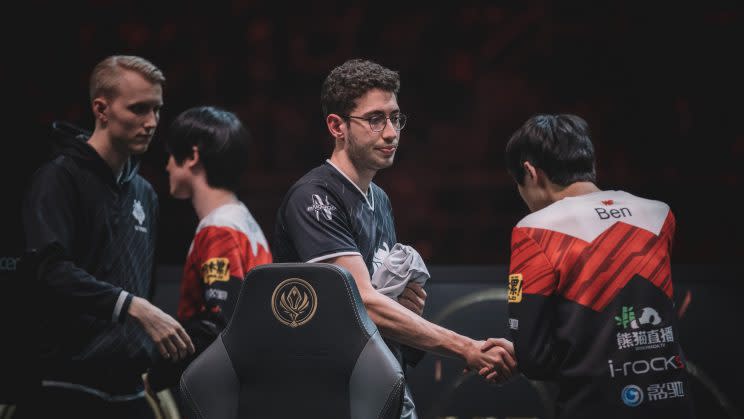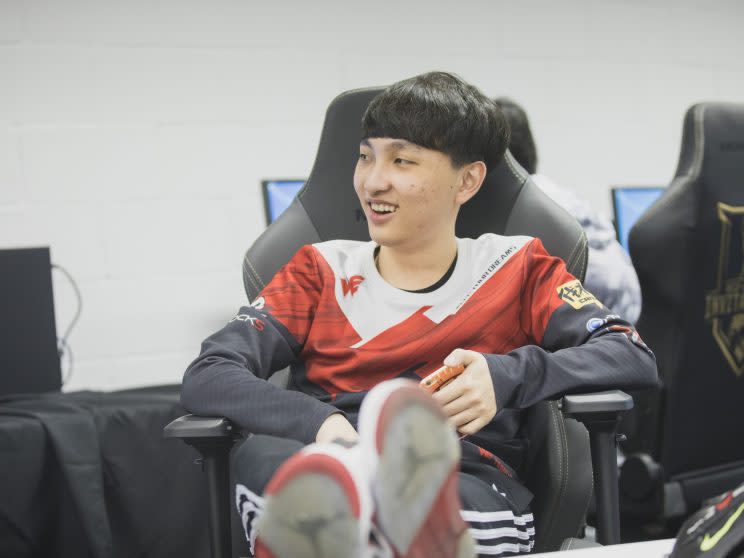The better G2 wins: G2 Esports and Team WE MSI semifinal preview

Team WE, China’s LPL representative, are a lot like G2 Esports — only better.
Both teams have one of the strongest laning bottom lanes in their region with a support that gets caught out a little too often in roams. Both teams have mid laners seeking redemption after past international performances. Both teams have junglers who take initiative from pushing lanes. Both teams’ top laners spent much of the split suffering in silence as mid and bottom get pressure.
All of this belies the fundamental difference between G2 Esports and Team WE: coordination between jungle and mid lane.
Luka “Perkz” Perkovik and Kim “Trick” Gangyun, G2’s core assets, have let the team down internationally — not just individually, but as a duo. In the first game against Team SoloMid, their rough initial setbacks came from a failure to use mid pressure to roam top as a duo with a low damage top laner. The second game against Team SoloMid, Perkz failed to acknowledge the location of Dennis “Svenskeren” Johnsen after Trick’s top side encounter. In both cases, G2 lost the early push and fell behind when they advantage was in their hands.
Perkz, to his credit, has performed significantly above his last international showings. He has bridged G2 from the early game to the late game in many circumstances with outstanding performances on Fizz and Orianna.
Su “xiye” Hanwei’s matchup against Perkz has its own historical significance. The last time xiye appeared on the international stage, he overwhelmed and dismantled Tigers’ Lee “Kuro” Seohaeng, but tripped and smashed his jaw into Team SoloMid’s Søren “Bjergsen” Bjerg and Svenskeren in the 2v2.
When xiye first debuted on the world stage, he had barely participated in matches for a major league. After only a few weeks of play in LPL 2014 Summer on WE Academy, Son “Mickey” Youngmin — then almost a one-trick Lee Sin mid player — replaced xiye as the team’s starter. xiye spent a year playing with the elite of Ionian solo queue. At 2015 IEM, he had placed top three in the ranks alongside Lee “Spirit” Dayoon and Jin “Mystic” Seongjun. WE added him and Mystic to their starting roster for the tournament at the behest of their current mid laner, Noh “Ninja” Geonwoo.
When TSM identified xiye’s limitations at 2015’s IEM Katowice, they punished his failure to identify an enemy jungler’s approach. Bjergsen avoided his all-ins, and xiye’s targeting unraveled in teamfights without a lane lead. Despite Team WE’s victory over the dominating Korean GE Tigers, they couldn’t win a game against North America’s Team SoloMid.
At 2017’s MidSeason Invitational, however, xiye’s impressive laning displays and ability to flank in teamfights has won him new international fans. His average experience advantage at 10 minutes of 245 throughout the Group Stage dwarf’s even Bjergsen’s, who came in second at only 3.

Thrust into the international spotlight with only meagre experience, Perkz has had a similar career trajectory. When he first appeared on the international stage a year ago during the 2016 Mid-Season Invitational, he had only played for a split in the EU LCS. That year’s MSI and the World Championship that followed displayed a cocky Perkz who collapsed after a handful of mistakes. He didn’t even have the luxury of catching anyone off-guard.
Given Perkz’s history, G2 fans no doubt frowned after his first deaths at the hands of SK Telecom T1. Of all the teams to face first, SKT would certainly lead to G2’s collapse.
Perkz remained steady. A crushing Fizz match with several highlight outlplays against Vietnam’s Gigabyte Marines kept G2 alive in a drawn out game on the second day of the tournament. He has managed to maintain pressure close to even matchups.
Statistically speaking, however, a few questions remain about how G2 transition pressure from Perkz’s leads. At the 2017 Mid-Season Invitational, Perkz boasts the highest CS difference at 10 minutes (4.5) of any mid laner at the event, but the lowest experience difference (-93). This suggests interference in his lane from his allied jungler because Perkz successfully took the CS, but split experience with a nearby champion.
Trick spent a great deal of time hovering near mid lane without result. When he could not find a mid lane gank opportunity, he chose to invade — at times apparently without alerting his mid laner — or waste time in the brush near Perkz’s lane. This disconnect created openings for the enemy team to abuse Trick’s plays, resulting in the worst performance of any jungler in Group Stage.
In the European LCS, Trick played more like WE’s Xiang “Condi” Renjie. He looked for openings to counter-jungle. His mid laner pushed out on his own. Over the course of the group stage, Condi adapted from an uncharacteristic habit of ganking and camping side lanes back to counter-jungling his opponent in the event that top, mid, or bottom won on their own. He became increasingly relevant in teamfights.
Trick attempted the same tactic with Nunu, but since G2 repeatedly drafted scaling lanes or made early misplays, they put themselves in a position where they had to wait for late game. As a result, Trick either lost out by waiting in lane brush or couldn’t defend against jungle invades, largely because enemy laners would accompany his assailants.
The Lucian mid lane pick against SKT exemplifies WE’s strength over G2 Esports. xiye has had more luck shoving the lane and opening invade opportunities for Condi. It doesn’t look like a late game scaling option, but it is; it relies on the use of a mid laner as a bridge, just like G2’s approach.
WE have a better understanding of how to position their jungler relative to their ability to get a laning lead. Over the course of the tournament, Condi’s movements have improved, leading the sense that WE as a team have improved. They set up well for Teleport plays in the opposing jungle after securing bot and mid lane leads. From their, they gain early aces, dragons and turrets.
G2 themselves fell pray to this tactic after a failed top side play against. At 11 minutes, they sent Tahm Kench and Elise to the top side against Gragas and Lee Sin, but lacked the damage with just Shen to make an impact before Perkz arrived. This play caused them to cede all control of bot side. With pushing bottom and mid lane, WE countered a bottom side engage with a 3-0 skirmish win three minutes later. Condi and xiye both answered the play almost immediately.
Domestically, WE’s inconsistencies merely made their own strategic predilections difficult to rely upon domestically. But WE would always get massive leads based on strong lane matchups and smart pathing when circumstances aligned.
While Perkz and Trick are individually strong in the EU LCS, they still lack a sense of how a mid and jungle duo operates. When I interviewed Perkz prior to MSI, I asked him if he thought there was a difference between a team having the best jungler and mid laner individually and a team with the best mid and jungle duo.
“I think there is no difference,” Perkz said. “I think it is the same thing. The reason why we are the best jungle-mid duo is because we are good at our roles, and we understand what each other has to do to win the game. That’s what many players do in EU. I think the mid jungle level is really good in EU. Febiven and Jankos. Every time we scrim them, they were playing really well with pressure. We could actually learn some stuff from them too, you know, Jankos is really good with playing with mid pressure, so we took some stuff from them.”
H2K-Gaming’s Marcin “Jankos” Jankowski and Fabian “Febiven” Diepstraten have a strong understanding of when and how to prepare waves to set up ganks. Their synergy and ability to maximize efficiency of their actions as a pair makes them the better duo, even if one believes that Trick or Perkz are better individual players.
Grasping this very concept has transformed xiye in particular from a domestic solo queue star into one of the LPL’s best mid laners. Originally a Twisted Fate main, xiye developed an ability to pressure the map over time. Rather than simply looking to out-trade and out lane his opponents, xiye learned how to set up a bottom side play at the appropriate power spike and coordinate with Condi on mid lane priority.
Both xiye and Perkz became better individual players, but WE’s larger holistic sense as a team lays more of an emphasis on mid and jungle synergy. Condi can take advantage of the flow minions from mid. xiye reacts well when his jungler requires follow-up.
Trick understands how to use mid pressure more than he did at last year’s MSI, but he doesn’t make as much of an effort to coordinate plays with his diligently pushing mid laner. This disconnect has caused both him and Perkz to find themselves caught out and set G2 behind. They form a holding pattern for late game teamfights that Team WE has managed to force apart with 1-3-1 play or counter-jungling.
WE do, however, fall apart because of a failure to prepare for opponent plays before level six. They managed to get lucky in their final game against SK Telecom T1 when Han “Peanut” Wangho exacerbated matters with a failed counter-gank, but left to their own devices before compositional power spikes, WE can fall behind.
Following that, WE’s midgame setups have had flaws. They default to trying to drag opponents to the bottom lane with their top laner, even when Ke “957” Changyu would be better off letting the wave push and the other lanes lack pressure. When the bait doesn’t work, they’ll attempt to force Baron.
WE’s pre-level six carelessness and gaps in Baron setup create an opening for G2 to succeed. Yet Ki “Expect” Daehan has performed worse than WE’s 957, which will continue to expose G2 to Teleport plays. Expect may not be able to punish 957 in split-pressure setups, and G2 haven’t had proper lane assignments either. Against highly mobile compositions, they have defaulted to turtling.

G2’s bottom lane makes its biggest impact after 40 minutes in grouped fights, so an ideal situation for G2 would be to try to control Baron vision, avoid the bait, and pull WE’s side lanes for a 50/50 contest and a team fight. Even when G2 and WE get to late game, however, Mystic has had better positioning as Kog’Maw this tournament than Jesper “Zven” Svenningsen. In the first game against WE, Zven contested vision solo and opened himself up for flanks and Ashe arrows.
It’s doubtful G2 can rely on pulling through against WE the same way they did against Flash Wolves, Marines, or Team SoloMid. WE have stronger duo play with their mid and jungle, but an even longer history than G2 of teamfighting. G2 may have focused much more on scaling and teamfighting this year, but WE’s iconic Baron steals and 5v5s from 2016 have nearly over-shadowed their improvements this year. And while WE’s lane assignments have sometimes lacked, one cannot call G2’s better.
If G2 want to win, they need to acknowledge when Condi takes initiative to invade. They need to understand how to control mid lane to prevent Condi and xiye from setting up control that spreads to the side lanes. Not only will this help G2 scout their opponents, but it may give them a new perspective on how they play their own game.
May the better G2 win.
You can follow Kelsey Moser on Twitter @karonmoser.

